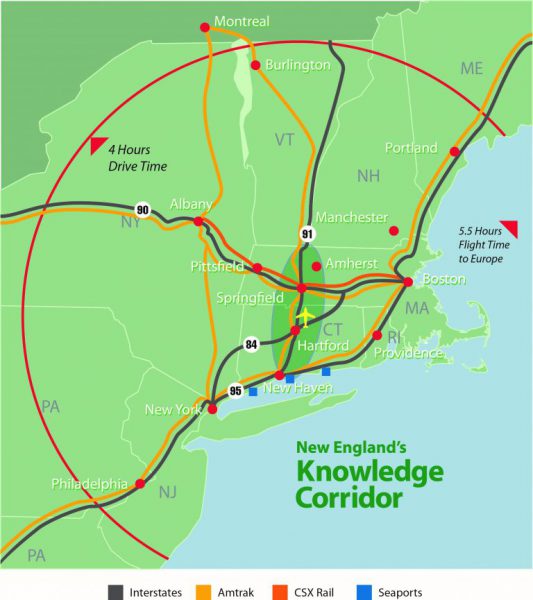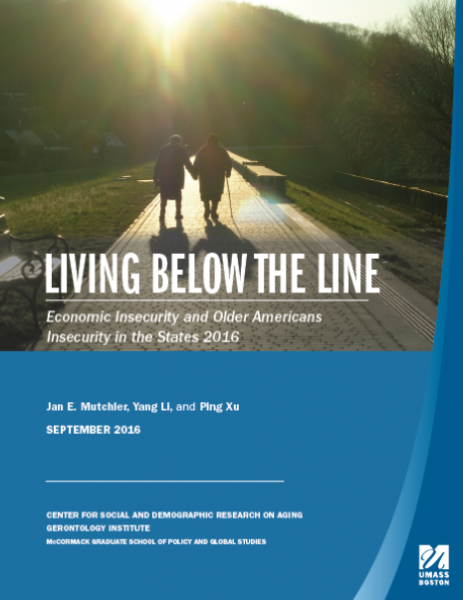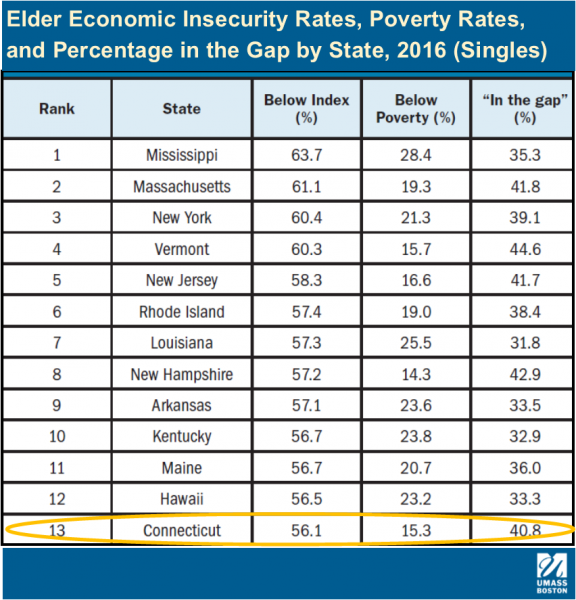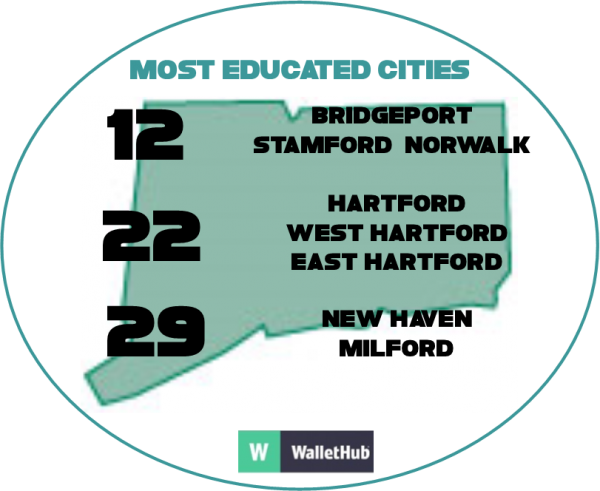For years, the tag line has been “innovation runs through it.” In the coming year, there will also be more frequent rail service running through it, and that may make all the difference in the world.
When proponents of economic development in what’s known as “New England’s Knowledge Corridor” get together for a conference this fall, it will be with the backdrop of the three anchor cities that span two states – New Haven, Hartford, and Springfield – being more connected than ever, with the start of the new regular rail service between the cities just months away.
The half-day conference, “Leveraging the Knowledge Corridor’s Transportation Assets and Investments to Drive Economic Progress,” will be held at Union Station in Springfield on October 18. It will serve as the coalition’s 2017 “State of the Region” conference.
The keynote speaker will be Robert Puentes, President/CEO of the Eno Center for Transportation. Panelists will include five members of Congress from the region: Richard Neal and James McGovern from Massachusetts and John Larson, Rosa DeLauro, and Elizabeth Esty from Connecticut.
Plans also include talks by Connecticut Commissioner of Transportation James Redeker and his counterpart in the Bay State, Stephanie Pollack, Secretary/CEO of the Massachusetts Department of Transportation. Officials also anticipate releasing the results of the 2017 New England Knowledge Corridor Business Survey.
"In the Knowledge Corridor, we’re convinced that the transportation assets we have; new ones that will be coming online in the next year or two, plus; those we are planning to see realized over a longer range time line constitute the bedrock of a competitive 21st century economy that enables ready and affordable access to skilled workers, attractive markets and motivated consumers on a global scale," Tim Brennan, Chairman of New England Knowledge Corridor Partnership and Executive Director of the Pioneer Valley Planning Commission, told CT by the Numbers.

On Monday, Governor Dannel P. Malloy announced that a joint venture of TransitAmerica Services and Alternate Concepts has been selected as the service provider that will operate and manage service on the Hartford Line – which is expected to launch in May 2018.
Work is continuing throughout the summer, including grade crossing upgrades in Wallingford this month, as part of the overall upgrade of the New Haven-Hartford-Springfield rail line – now branded as the CTrail Hartford Line, with expanded service scheduled to being in 2018, according to transportation officials. Last month, construction in Meriden and Windsor included track construction upgrades.
New England’s Knowledge Corridor is an interstate partnership of regional economic development, planning, business, tourism and educational institutions that work together to advance the region’s economic progress. The region “transcends political boundaries,” officials point out, and it comprises the Hartford, Springfield and New Haven metro areas and is centered on seven counties in the two states, underscoring the area’s “rich tradition of inventions, research and higher education.”
The New Haven-Hartford-Springfield (NHHS) Rail Program is a partnership between the State of Connecticut, Amtrak and the Federal Railroad Administration. The goal is to provide those living, working or traveling between New Haven, Hartford and Springfield with high speed rail service equal to the nation’s best rail passenger service, officials emphasize.
 The Hartford Line will act as a regional link with connections to existing rail services, including Metro-North, Shoreline East, and Amtrak Acela high-speed rail services on both the New Haven Line to New York and on the Northeast Corridor to New London and Boston. There will also be direct bus connections to the Bradley Airport Flyer and to CTfastrak. With a heightened level of direct and connecting service linking the region, the hope is that towns along the future Hartford Line will become magnets for growth – ideal places to live and to relocate businesses that depend on regional markets and travel.
The Hartford Line will act as a regional link with connections to existing rail services, including Metro-North, Shoreline East, and Amtrak Acela high-speed rail services on both the New Haven Line to New York and on the Northeast Corridor to New London and Boston. There will also be direct bus connections to the Bradley Airport Flyer and to CTfastrak. With a heightened level of direct and connecting service linking the region, the hope is that towns along the future Hartford Line will become magnets for growth – ideal places to live and to relocate businesses that depend on regional markets and travel.
All of which dovetails perfectly with the “selling points” routinely used to promote the Corridor:
- Academic Powerhouse – One of the country’s highest academic concentrations and largest capacities for research, with 41 colleges and universities and 215,000 students
- Exceptional Achievement – Consistently among the nation’s top 10 in percentage of the population with advanced degrees, science-engineering doctorates and new patents registered
- Big, Concentrated Market – The nation’s 20th largest metro region, with over 2.77 million people, is comparable to Denver and St. Louis, but with twice their population density, which means ready access to labor and consumers
- Large Workforce – A labor force of 1.34 million, 50% larger than the Charlotte metro area
- Business Hub – 64,000 businesses – 60 percent more than the Austin metro
"Providing frequent, reliable, commuter rail service connecting New Haven-Hartford-Springfield, the three major cities that anchor the Knowledge Corridor and its over 2.7 million people, will be nothing short of a game changer enabling the cross border region’s to reach its potential as an economic powerhouse within New England while simultaneously linking it to the white hot economies found in the Boston and New York City mega regions," Brennan added.
The CTrail Hartford Line rail service will operate at speeds up to 110 mph, cutting travel time between Springfield and New Haven to as little as 81 minutes. Travelers at New Haven, Wallingford, Meriden, Berlin, Hartford, Windsor, Windsor Locks and Springfield will be able to board trains approximately every 30 minutes during the peak morning and evening rush hour and hourly during the rest of day, with direct or connecting service to New York City and multiple frequencies to Boston or Vermont (via Springfield). New train stations also are in various stages of development in North Haven, Newington, West Hartford and Enfield.
 Also, very much a part of the strengthening transportation options with the potential to spur economic development is Bradley International Airport, which recently has added international flights on Aer Lingus (last year) and Norwegian Air (last month) and a direct-to-San Francisco route via United Airlines.
Also, very much a part of the strengthening transportation options with the potential to spur economic development is Bradley International Airport, which recently has added international flights on Aer Lingus (last year) and Norwegian Air (last month) and a direct-to-San Francisco route via United Airlines.
Connecticut Airport Authority Executive Director Kevin A. Dillon said the aim is to “build on Bradley’s strengths and continue our focus to deliver more convenience and connectivity for our region. Flying to Europe from Bradley has never been easier and more affordable.”
The Connecticut Department of Transportation (CTDOT) conducted a bidding process and cost-benefit analysis for the Hartford Line program and selected TransitAmerica Services and Alternate Concepts, which are forming a joint venture solely for the purpose of serving the Hartford Line. This marks the first time that CTDOT has been able to select and contract with an experienced service provider for a major transportation program, a more cost-efficient alternative to the agency creating a separate internal unit and hiring employees to manage the Hartford Line, according to state officials.








 Attracting hundreds of women in manufacturing from across the country, WiM's annual Summit is the only national conference of its kind. This networking and educational event features manufacturing plant tours, professional development tracks, industry roundtables, keynote presentations and social events to expand participants' networks.
Attracting hundreds of women in manufacturing from across the country, WiM's annual Summit is the only national conference of its kind. This networking and educational event features manufacturing plant tours, professional development tracks, industry roundtables, keynote presentations and social events to expand participants' networks. any, TRUMPF Inc., and Pratt & Whitney, all on the opening day of the conference on September 13.
any, TRUMPF Inc., and Pratt & Whitney, all on the opening day of the conference on September 13. Engineers, and George Saiz, President & CEO of The Association for Manufacturing Excellence.
Engineers, and George Saiz, President & CEO of The Association for Manufacturing Excellence. Among the host committee members is the Connecticut Business and Industry Association. The New Haven Manufacturers Association and the Waterbury Regional Chamber’s Manufacturer’s Council are among the Supporting Partners for the Summit.
Among the host committee members is the Connecticut Business and Industry Association. The New Haven Manufacturers Association and the Waterbury Regional Chamber’s Manufacturer’s Council are among the Supporting Partners for the Summit.






 For example, almost a quarter (23%) of Connecticut workers in science, technology, engineering, and math fields such as healthcare and bioscience were immigrants. Over 36,000 foreign-born Connecticut residents are self-employed, with immigrant-owned businesses generating $1.1 billion income in 2014 while employing 73,047 people. “Immigrants are already playing a huge part ensuring that Connecticut remains a leading innovator in industries like healthcare and bioscience,” according to the analysis.
For example, almost a quarter (23%) of Connecticut workers in science, technology, engineering, and math fields such as healthcare and bioscience were immigrants. Over 36,000 foreign-born Connecticut residents are self-employed, with immigrant-owned businesses generating $1.1 billion income in 2014 while employing 73,047 people. “Immigrants are already playing a huge part ensuring that Connecticut remains a leading innovator in industries like healthcare and bioscience,” according to the analysis.




 The Hartford Line will act as a regional link with connections to existing rail services, including Metro-North, Shoreline East, and Amtrak Acela high-speed rail services on both the New Haven Line to New York and on the Northeast Corridor to New London and Boston. There will also be direct bus connections to the Bradley Airport Flyer and to CTfastrak. With a heightened level of direct and connecting service linking the region, the hope is that towns along the future Hartford Line will become magnets for growth – ideal places to live and to relocate businesses that depend on regional markets and travel.
The Hartford Line will act as a regional link with connections to existing rail services, including Metro-North, Shoreline East, and Amtrak Acela high-speed rail services on both the New Haven Line to New York and on the Northeast Corridor to New London and Boston. There will also be direct bus connections to the Bradley Airport Flyer and to CTfastrak. With a heightened level of direct and connecting service linking the region, the hope is that towns along the future Hartford Line will become magnets for growth – ideal places to live and to relocate businesses that depend on regional markets and travel. Also, very much a part of the strengthening transportation options with the potential to spur economic development is
Also, very much a part of the strengthening transportation options with the potential to spur economic development is 
 Rounding out the top 10 are Wisconsin, Iowa, New Hampshire, Louisiana, Rhode Island, Colorado, Nebraska and South Dakota. The states were ranked based on the most gyms using these four categories: total number of gyms, state population in 2016, people per gym, and gyms per capita (100,000 people). Totals were based on the 14 largest gym chains in America. There were more than 36,000 health clubs in the U.S. last year, up from 29,000 a decade ago.
Rounding out the top 10 are Wisconsin, Iowa, New Hampshire, Louisiana, Rhode Island, Colorado, Nebraska and South Dakota. The states were ranked based on the most gyms using these four categories: total number of gyms, state population in 2016, people per gym, and gyms per capita (100,000 people). Totals were based on the 14 largest gym chains in America. There were more than 36,000 health clubs in the U.S. last year, up from 29,000 a decade ago.


























